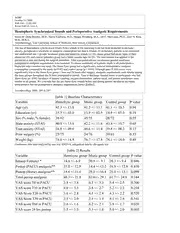
Research 2008 - Hemispheric Synchronized Sounds and Perioperative Analgesic Requirements - Dabu-Bondac et al PDF
Preview Research 2008 - Hemispheric Synchronized Sounds and Perioperative Analgesic Requirements - Dabu-Bondac et al
A1267 October 21, 2008 9:00 AM - 11:00 AM Room Hall E2-Area A, Hemispheric Synchronized Sounds and Perioperative Analgesic Requirements Susan M. Dabu-Bondoc, M.D., Nalini Vadivelu, M.D., Megan Weinberg, M.A., Jill E. MacLaren, Ph.D., Zeev N. Kain, M.D., M.B.A. Anesthesiology, Yale University School of Medicine, New Haven, Connecticut The use of hemispheric synchronized (Hemi-Sync) sounds in the operating room has been promoted to decrease anxiety, perioperative anesthetic or analgesic consumption but data is limited. 60 ambulatory patients were consented and randomized into 3 groups: treatment group had hemisync sounds (n=20), music group had music tapes of their choice (n=20), and control (placebo) group had a blank cassette tape (n=20). The intervention was applied in the preoperative area and during the surgical procedure. After a propofol-nitrous-vecuronium general anesthesia perioperative analgesic requirements were recorded. To ensure uniformity of hypnotic depth in all participants a bispectral index monitor was used. The Hemi-Sync group had a significantly reduced intraoperative analgesic consumption compared to the music (p=0.02) and control group (p = 0.04). Although pain (VAS) scores were significantly less in the Hemi-Sync group 1 hour and 24 hours after surgery, analgesic requirements were similar among the three groups throughout the 24 hour postoperative period. Time to discharge trended lower in participants who had Hemi-Sync (p=.058); incidence of nausea/vomiting, oxygen desaturation. patient recall, and patient satisfaction were similar in all groups. We conclude that the use Hemi-Sync sounds before and during general anesthesia decreases intraoperative but not postoperative analgesic requirements.[table1][table2] Anesthesiology 2008; 109 A1267 [table 1] Baseline Characteristics Variable HemiSync group Music group Control group P value Age (yr) 42.3 +/- 13.8 41.2 +/- 13.1 41.1 +/- 10.5 0.94 Education (yr) 15.5 +/- 03.0 13.9 +/- 02.5 14.9 +/- 03.0 0.19 Sex (% male; % female) 38/62 45/55 28/72 0.55 State anxiety (STAI) 40.0 +/- 13.0 42.2 +/- 11.6 43.4 +/- 10.7 0.65 Trait anxiety (STAI) 34.8 +/- 09.0 40.6 +/- 11.4 39.8 +/- 08.2 0.13 Prior surgery (%) 25/75 24/76 39/61 0.53 Weight (kg) 74.6 +/- 14.9 76.7 +/- 17.8 74.1 +/- 18.0 0.88 Continuous data were analyzed by one way ANOVA, categorical data by chi-square test [table 2] Results Variable Hemisync group Music group Control group P value Intraop Fentanyl * 14.6 +/- 6.9 20.9 +/- 9.1 20.3 +/- 9.4 0.046 Postop (PACU) analgesic** 15.0 +/ 12.9 14.4 +/-13.2 16.9 +/- 12.8 0.830 Postop (Home) analgesic** 18.6 +/-11.6 28.0 +/-16.4 25.0 +/- 13.1 0.099 Total periop analgesic 48.3+/- 21.8 62.6+/- 29.1 61.7+/- 24.0 0.144 VAS score T0 in PACU 3.8 +/- 3.4 4.5 +/- 3.3 5.4 +/- 2.5 0.300 VAS score T10 in PACU 4.0 +/- 3.3 3.8 +/- 2.7 5.2 +/- 2.3 0.258 VAS Score T20 in PACU 3.6 +/- 2.8 4.5 +/- 2.4 4.3 +/- 2.2 0.520 VAS Score T30 in PACU 3.5 +/- 2.0 3.4 +/- 1.4 4.1 +/- 2.4 0.541 VAS score T60 in PACU 2.6 +/- 1.6 4.2 +/- 2.1 3.9 +/- 1.7 0.020 VAS score 24 hrs postop 3.5 +/- 1.5 5.3 +/- 1.8 5.0 +/- 2.0 0.005 Discharge time 120.2 +/-37.3 156.6 +/-65.6 162.8 +/-68.2 0.058 PONV 0.1 +/- 0.5 0.2 +/- 0.4 0.2 +/- 0.4 0.608 Recall 0 0 0 N/A Patient satisfaction 3.9 +/- 0.2 4.0 +/- 0.2 3.9 +/- 0.4 0.124 Total propofol (mcg/min/kg)*** 0.18 +/- 0.06 0.17 +/- 0.04 0.20 +/- 0.13 0.43 *fentanyl requirements in mcg converted to IV morphine mg equivalents
